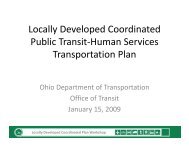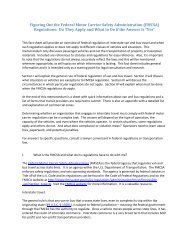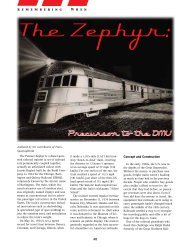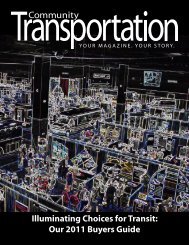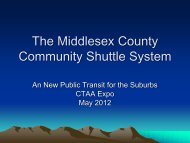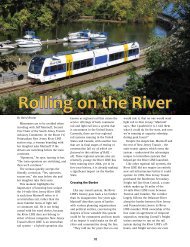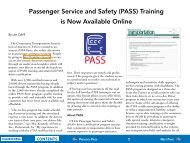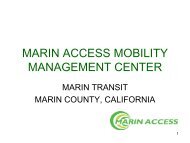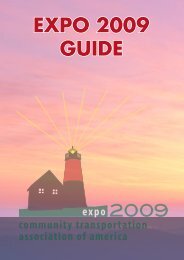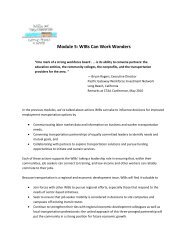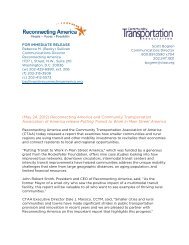San Luis Obispo - Caltrans - State of California
San Luis Obispo - Caltrans - State of California
San Luis Obispo - Caltrans - State of California
Create successful ePaper yourself
Turn your PDF publications into a flip-book with our unique Google optimized e-Paper software.
SAN LUIS OBISPO REGION<br />
COORDINATED HUMAN SERVICES-PUBLIC TRANSPORTATION PLAN<br />
human services providers with 115 vehicles. Not included are an additional 85 vehicles<br />
reported by two school districts and by commercial providers which could be double counted<br />
among vehicles reported by their contracting agencies. The age <strong>of</strong> vehicles was not<br />
collected in this survey, but other surveys have shown human service agency vehicles to be<br />
generally older, with substantially higher mileage as compared with vehicles operated by<br />
public transit agencies. Responding agencies did indicate that just 15 percent <strong>of</strong> the human<br />
service agencies are lift-equipped, wheelchair accessible, contrasting sharply with the public<br />
transit vehicles <strong>of</strong> which six out <strong>of</strong> ten are lift equipped.<br />
Expenditures Reported<br />
Information on expenditures and their sources was notably different between the two sectors,<br />
public transit versus human and social services. While $11.7 million was reported in total<br />
operating expenditures, these funds were expended differently between the two groups.<br />
Public transit accounted for almost $10 million, 93 percent <strong>of</strong> all funds reported. Transit<br />
providers are allocating eight out <strong>of</strong> ten dollars into direct vehicle operations, with another two<br />
in ten dollars expended for administration or for vehicle replacements. Less than one<br />
percent is going to special bus pass, bus token or mileage reimbursement/ taxi voucher<br />
programs.<br />
Human and social service providers reported a much smaller proportion <strong>of</strong> the total dollars<br />
expended at $778,000 (7 percent), with about one-third used for direct vehicle operations.<br />
Only three percent <strong>of</strong> reported human services’ dollars is expended for vehicle replacement.<br />
Vehicle replacement is less than one percent. Almost one quarter <strong>of</strong> these funds are<br />
expended for mileage reimbursement, bus passes/ tokens and taxi vouchers. Less than one<br />
percent <strong>of</strong> funds was reported for administration <strong>of</strong> human service transportation programs.<br />
The significant subsidy that CalPoly provides to SLO Transit for its university students<br />
accounted for 41 percent <strong>of</strong> reported human services transportation expenditures.<br />
Funding sources are substantially different in that city-operated systems and public transit<br />
operators report continuing, stable funding from federal, state and local dedicated transit<br />
sources. Human and social service agencies/organizations reported private donations,<br />
general fund allocations and special grants. For many human and social service<br />
agencies/organizations, particularly the smaller ones, funding availability from year to year is<br />
an on-going issue.<br />
Infrastructure Differences<br />
Public transit operators have access to formula funding for vehicle replacement which helps<br />
to ensure that high percentages <strong>of</strong> their vehicle fleets are lift-equipped. In addition, transit<br />
agencies have funding for facilities to maintain vehicles and staffing to regularly perform<br />
preventative vehicle maintenance. There is the increasing introduction <strong>of</strong> technology to<br />
perform both administrative and operational support functions, such as data management<br />
and accounting, billing, trip scheduling, dispatching, AVL, automated fare payment and call<br />
taking and information applications. Such infrastructure does not commonly exist within the<br />
human service systems, the exception being the developing maintenance facility for RTA and<br />
Ride-On transportation programs.<br />
98<br />
OCTOBER 2007



